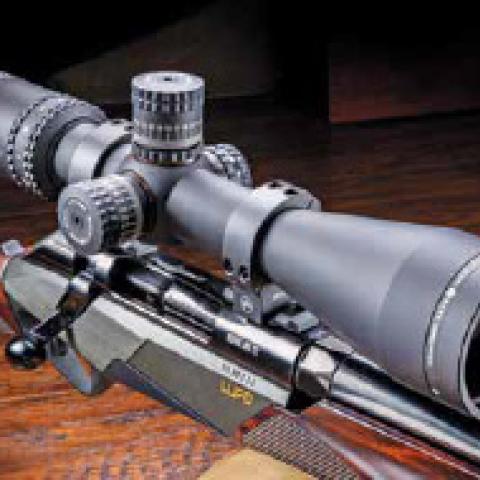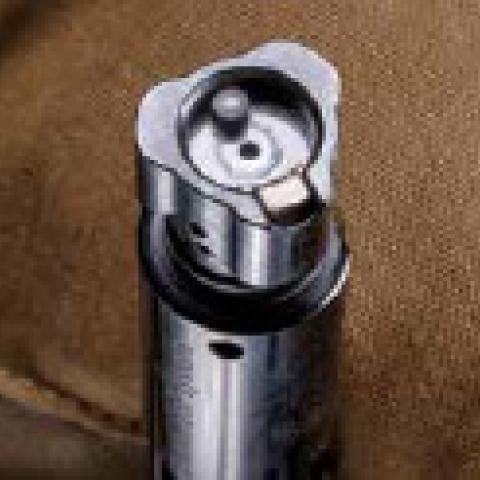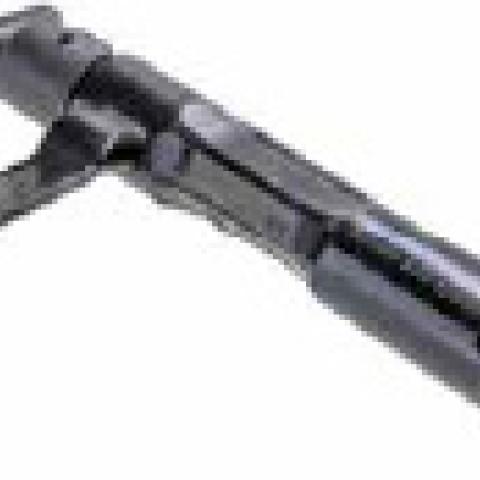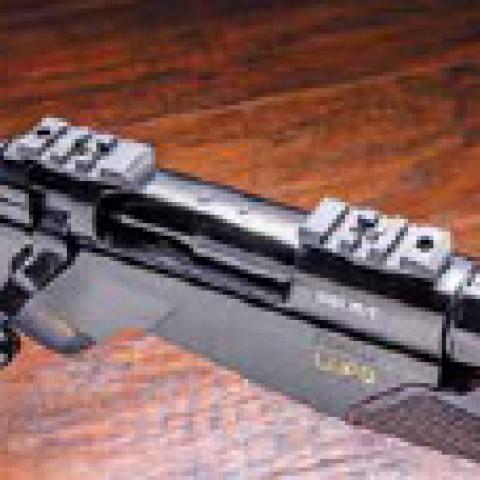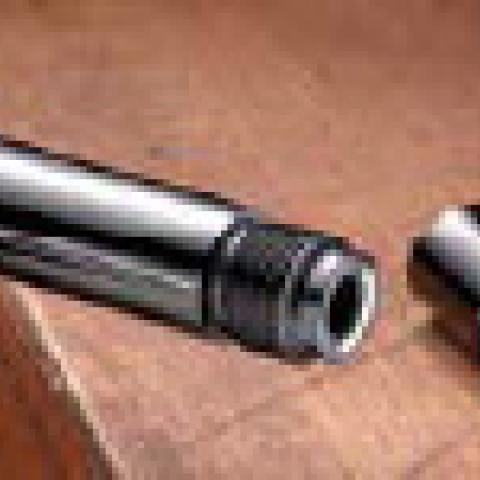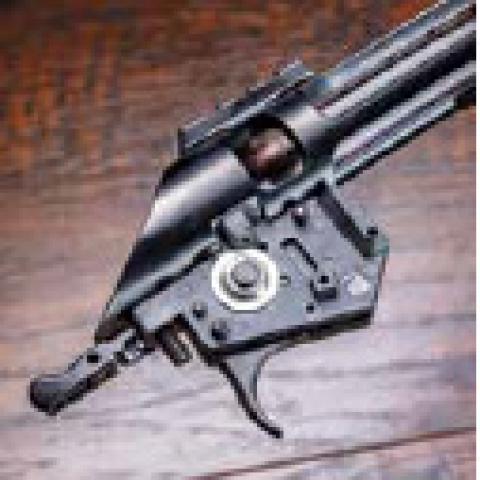TIMBER WOLF
Two years ago, Benelli shocked the shooting world with the unveiling of the brand’s first-ever, bolt-action centerfire rifle. Dubbed the LUPO (Italian for wolf), this new gun represented a departure for Benelli, which had been known primarily as a shotgun brand. It was also a departure from conventional bolt-action design; like Benelli’s shotguns, the LUPO brought several unique innovations to the market and challenged conventional boltgun construction and styling.
For 2022, Benelli has expanded their LUPO line, and while the new Benelli rifles introduced this year share the same mechanical elements as the original, they offer several upgrades. The most noteworthy is the addition of Benelli’s BE.S.T. (Benelli Surface Treatment), which is very likely the most durable finish ever applied to a rifle.
The most stunning of the new rifles is the BE.S.T. LUPO Walnut. As the name implies, the stock is made from wood. The AA satin finish walnut is exceptional, looking as though it was borrowed directly from one of Benelli’s premium shotguns. When I spoke with George Thompson, Benelli USA’s director of product management, he told me that various gun companies grade walnut differently, but the wood on the LUPO is extremely good-looking.
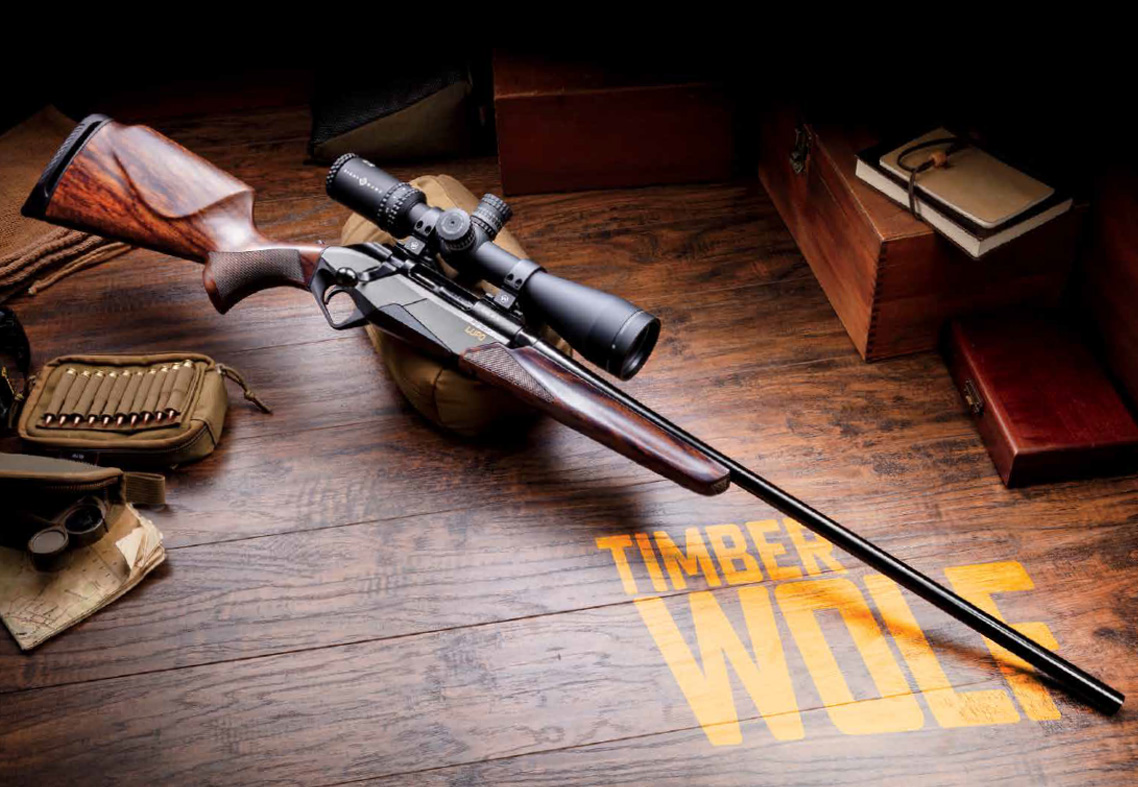
“The LUPO Walnut was originally supposed to be a limited-edition rifle,” says Thompson. “However, the feedback was so positive that we decided to add it to the LUPO line permanently.”
Unlike other bolt guns, the LUPO utilizes a two-piece stock similar to a shotgun. For years, we’ve been taught that two-piece stocks like those found on lever-action and some semiauto rifles limited accuracy potential, which is generally true. Benelli developed an ingenious way to solve the problem by utilizing a new and innovative bedding system for their rifle. The LUPO’s barreled action sits inside an aluminum chassis with the barrel extension bedded to a block of steel, so the LUPO is a chassis rifle. It doesn’t look or carry like a chassis rifle, but it shoots like one.
The chassis design allows Benelli to make modifications that are impossible with traditional bolt actions. For starters, the stock design incorporates the chassis and a separate forearm and buttstock, so owners can modify the stock dimensions of the LUPO the same way they would a shotgun. Using the supplied spacers, drop and cast can be adjusted to 36 different positions, and length of pull can be modified from 13.8 to 14.75 inches.
The LUPO’s stock design also includes recoil reduction technology carried over from Benelli’s shotguns. Known as Progressive Comfort, the system utilizes interlocking rubber fingers within the stock that compress under the force of recoil, effectively dampening the impact. I suspected incorporating Progressive Comfort to bolt-action rifles might prove challenging, but Thompson told me that it’s actually simpler to apply this technology to rifles than shotguns.
“With shotguns, you have a broad range of recoil,” said Thompson. “Everything from light field loads to really heavy magnums. But with rifles, you have a much more standardized recoil profile.”
Thompson told me that my test rifle, which was chambered in .300 Winchester Magnum, utilizes a specific baffle system that is customized to the recoil of that round. By fine tuning the Progressive Comfort system to caliber, perceived recoil is dampened significantly, and since there’s less variation in recoil from a single centerfire cartridge than from a shotgun gauge, tuning the dampers for a rifle is far simpler.
The LUPO’s receiver and action look quite different than a traditional bolt rifle. The receiver, which is made from aluminum alloy, receives a bronze anodized finish, while the BE.S.T. barrel and action are gloss black. The bolt itself also receives the BE.S.T. treatment and features a three-lug design that reduces bolt lift to 60 degrees for faster cycling. When viewed from the side, the bolt body appeared whittled down near the center, but there’s an important reason for that wasp-waisted profile, Thompson says.
“By reducing the diameter of the bolt in the middle, we can increase the magazine capacity by at least one round. It also allows the cartridge to ride higher in the magazine and positions it more in line with the chamber.”
Because the cartridge doesn’t have to “climb” from the magazine, you can expect very smooth cycling from the LUPO. The polymer magazine takes up a substantial portion of the lower receiver.
Atop the LUPO’s cylindrical receiver, you’ll find three sets of tapped holes for mounting scope bases. The three-position design is extremely sturdy but also offers more options when mounting an optic. Benelli offers two-piece bases and a one-piece rail for the rifle, but you can also use two rear bases for a Model 700 rifle if needed.
Crio barrels have been a standard feature on Benelli shotguns for many years, and that same technology has found its way into their rifles. The basic concept of Crio barrels is simple; exposing the barrel to very cold temperatures relieves stress and smooths the surface of the steel.
FIRST TO THE FINISH
We hear so much about firearms finishes that we’ve almost grown immune to the various trade names for different surface treatments, but Benelli’s BE.S.T. treatment is unique.
"I grew up hunting ducks on Chesapeake Bay, and rust was a way of life,” says Thompson. “I hated rust, and I wanted our guns to have the best rust protection available.”
To make this happen, Benelli tested a wide range of surface treatments and finishes, but they couldn’t find one treatment that was substantially better than the others. So, Benelli set out with the ambitious goal to develop a surface treatment superior to anything that existed.
Benelli began their quest to create the ultimate surface treatment in 2009 by examining existing surface treatments, and one technique that appeared promising was physical vapor deposition (PVD). PVD coatings are popular on machined parts because they create a surface that is as much as 10 times harder than the base material, is inert, and resists oxidation. They also examined PECVD, or plasma-enhanced physical vapor deposition.
Plasma treatments were desirable because they changed the surface structure of the material to make it more durable, but the problem with plasma treatments is that, for the most part, they must be applied at very high temperatures. That excessive heat can stress metals, but Benelli found a way to apply their special plasma treatment — BE.S.T. — at cold temperatures. It’s revolutionary, and Benelli is fiercely guarding the surface treatment secret.
“Benelli didn’t even patent the process,” says George Thompson.
Patents require a detailed explanation of methodology, and Benelli’s engineers weren’t interested in revealing how they managed to apply a cold plasma treatment to their firearms without the damage associated with high heat. I suppose you could call it Benelli’s BE.S.T. kept secret.
The result of BE.S.T. treatment is an incredibly hard surface that resists scratches, nicks, scrapes, and the corrosive effects of chemicals like salt. Initially offered on their waterfowl shotguns, Benelli offered some dramatic displays of the BE.S.T. treatment’s impressive capabilities, including leaving BE.S.T. barrels exposed to the elements for weeks on end and even striking the metal surface with car keys. After slapping the barrel of a Super Black Eagle BE.S.T. with a housekey a half-dozen times, the marks left by the keys simply wiped away without a trace. It looks like Benelli has earned their claim of having the best surface treatment on the market.
FIELD TESTING
During the summer of 2019, I was informed that Benelli was working on a secret bolt-action rifle and was invited to travel to Africa to test out the new gun. That initial prototype rifle wore an all-black stock, and I wasn’t sure how the shooting world would respond to the rifle’s new look. But there were no doubts regarding the rifle’s accuracy; that initial rifle would place five Hornady GMX bullets into an inch at 100 yards. It was the most accurate offthe- shelf .30-’06 I’d tested to that point.
The first Benelli LUPO I tested placed five shots under an inch at 100 yards and so will the new BE.S.T. version. The test rifle, which was chambered in .300 Winchester Magnum (it’s also available in 6.5 Creedmoor), produced a best group of .45 inches for three shots at 100 yards with match ammo. Benelli promises sub-MOA accuracy, but even with five shots, the two match loads in the test averaged at or just under an inch with the best groups hovering in the .8-inch range. Backing out to 200 yards, the Benelli produced a 1.82-inch group and remained sub-MOA to 400 yards, the maximum distance on the test range.
I looked back at my range notes from the original Benelli test in 2019 and found that rifle shot sub-MOA, five-shot groups at 100 yards with two of the three test loads, just like the BE.S.T. LUPO Walnut tested here. That means the two LUPO factory rifles tested produced five-shot groups under an inch with two-thirds of the factory loads tested. When I spoke to George Thompson, he told me that one of the LUPO’s best attributes is its ability to shoot well with a wide range of loads, and my own evaluation supports what he says.
The Benelli’s stock design is stylish, but it’s also practical. It’s not as mechanized as some modern chassis rifles with knobs and rails, but the LUPO Walnut’s stock is easy to adjust, and its modification capabilities allow this rifle to be tailor made to any shooter. Swells on the pistol grip fill the hand, and while some target shooters might prefer a more vertical grip, the LUPO’s design is comfortable to shoot from a prone position. The tang-mounted, two-position safety is easy to access and manipulate thanks to a rounded knob, and when you are resting your face on the comb of the rifle, it’s easy to glance down and determine its condition. The sharply angled triggerguard is easy to access, and the trigger itself is crisp and clean with no noticeable take-up of creep. It’s adjustable from 2 to 4 pounds, and the test rifle’s trigger came set at 2.4 pounds.
There are convenient features found throughout, which make the Benelli BE.S.T. LUPO Walnut a competent, if slightly unconventional, long-range rifle. Will the LUPO shake up rifle design the way Benelli’s shotguns have shifted that market? Time will tell, but one thing that’s certain is that the new LUPO is poised to become one of the new leaders of the long-range rifle pack.
Content courtesy of Outdoor Sportsman's Group
